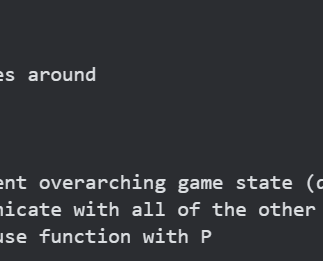
about me
I am a graduate MA Game Design student with a 1st Class Honour Bachelor in Game Design. One of the things I love is stories. For me, the process of weaving stories into all of their multitudes is utterly amazing, especially in games. Games are made of so many different disciplines, but game design is what brings them all together and makes them play in harmony, whetehr it is for fun or for more serious matters.
Being a self-motivated, highly creative individual, I want to learn and work together with a team to create something amazing and enjoyable. I have experience with creating projects from the very first brainstorming session to finishing them in the set time frame.
projects
Solargram's Fix It Shop
Role
Programmer, Game Designer
Development Time
1-2 Months
Genre
Solarpunk
Platform
Web Gl
Engine (Programming Language)
Unity (C#)

Take a Look at the Game
Short Summary
Embark on a solarpunk journey in a world shattered by the climate crisis! Immerse yourself in a game where repairing items and connecting with survivors are the main mechanics.
Prompted by "Solarpunk Grandma," our team researched to craft a solarpunk-themed game. We implemented mechanics rooted in the four R's—Repair, Reuse, Recycle, Renew. I assumed the role of the main programmer, actively managing tasks and collaborating with multiple team members. Prioritizing accessibility, I ensured my code was user-friendly, extensively commented, and communicated effectively to facilitate understanding. The project involved the creation of a 3D game, emphasizing consistent communication and meticulous time management.
Aims
Create a solarpunk themed game
Create mechanics based on the four R’s (Repair, Reuse, Recycle, Renew)
Hold the role of main programmer in the group and help with managing tasks
Work with several people together
Make my code very accessible and easy to use for other people
Goals
Create a 3D game
Comment my code a lot
Keep communicating
Time Management
Reflection
Reflecting on the aims, the solarpunk theme was successfully integrated, with the repair mechanic aligned with the four R's. The main programmer role was assumed to drive project progress, manage tasks, and ensure effective communication. Challenges included defining a "good repair" variable and integrating narrative elements into the system. Source control, using PlasticSCM, proved effective for collaboration, though terminology issues caused confusion.
Critical reflecting identified successes in communication, game playability, and achieving personal goals. Areas for enhancement encompassed better time management, exploration of Unity's UI builder, and addressing omitted systems due to time constraints. Future improvements should focus on refined long-term planning, employing an agile approach for clearer project phases, and incorporating additional visual effects, storage, and a reward system.
Development Log
Early Development
Integration of Systems
Game Design: The collaboration with a teammate to integrate NPC, Queue, and Workshop systems indicates a pivotal early decision in establishing the foundation of the game. This reflects a strategic approach to weave different gameplay aspects seamlessly.
Programming: During this phase, scripts were identified, and preliminary plans were laid out for merging two separate scripts. The focus was on understanding the interdependencies and potential challenges.
UI Design Exploration
Game Design: Acknowledging the need for a comprehensive UI, the decision to explore the UI toolkit and Unity's UI builder shows a commitment to creating an intuitive and user-friendly interface.
Programming: While experimenting with the UI builder, a realization of the learning curve and time constraints led to an adaptive decision to hard code elements. This demonstrated practical problem-solving skills and a flexible approach to development.
Mid-Development
Cutscene Manager and Narrative Integration
Game Design: The introduction of a cutscene manager and narrative integration demonstrates an effort to enhance storytelling within the game. This decision adds depth to the player experience.
Programming: Implementing the cutscene manager and integrating narrative elements reveals a focus on creating a cohesive and engaging game loop. Troubleshooting during this phase also indicates an adaptive and resilient programming approach.
Bug Fixes and Version Control
Programming: The identification and resolution of bugs affecting the main game loop showcase a commitment to maintaining stability and functionality. The emphasis on version control reflects a proactive stance to prevent disruptions during collaborative development.
Late Development
Onboarding System
Game Design: The initiation of the onboarding system underscores a focus on user experience and the desire to guide players seamlessly into the game world. Early considerations for pacing indicate foresight into the player's initial interactions.
Programming: The initial implementation of the onboarding system speaks to a methodical coding approach, prioritizing key elements for player immersion and understanding.
Optimization and Additional Features
Programming: Scene optimization and addressing player-phasing issues highlight a commitment to delivering a smooth and bug-free gameplay experience. The decision to enhance visual consistency through adjustments aligns with the pursuit of a polished final product.
Game Design: Iterative improvements during this phase emphasize the dedication to refining the game's visual elements and user experience.
Audio Manager and Sound Effects
Programming: The creation of an audio manager and incorporation of sound effects demonstrate a recognition of the importance of audio in enhancing immersion. This decision adds a layer of depth to the overall gaming experience.
Game Design: The emphasis on enhancing the player experience through well-implemented audio cues aligns with a holistic approach to game design.
Final Polishing and Build Preparation
Game Design: Final adjustments for visual consistency and user experience signify the commitment to delivering a polished product. Decisions made during this phase reflect a balance between design aspirations and practical considerations.
Project Management: Decision-making on build readiness and preparation for submission indicates a strategic and organized approach to the final stages of development. It reflects a collaborative effort to ensure the project is submission-ready.


















